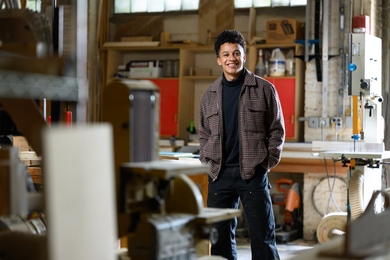The leader of an MIT team that created the nanoruler, the world's most precise ruler with 'ticks' only a few hundred billionths of a meter apart, has been named one of the "R&D 100" for 2004.
The R&D 100 is an annual listing, produced by R&D magazine, to honor the year's most significant new technological products and processes. Winners are selected by R&D editors along with experts in a variety of disciplines.
Two other MIT researchers also won, sharing their awards with industry and government colleagues. A black-tie banquet was held in Chicago last week to celebrate the 2004 awards.
R&D 100 award-winner Mark Schattenburg, director of MIT's Space Nanotechnology Laboratory in the Center for Space Research, guided researchers in building the nanoruler, whose speed and precision for patterning parallel lines across large surfaces could affect fields from the manufacture of computer chips to space physics.
Shuguang Zhang, associate director of the Center for Biomedical Engineering, was an R&D 100 co-awardee with 3DM, a privately held specialty biomaterials and medical device company, for the invention of PuraMatrix Synthetic Peptide Hydrogels.
The hydrogels are used to develop medical devices and in drug discovery, tissue engineering and cell migration and invasion, among other areas. For researchers in these fields, PuraMatrix Hydrogels may be used to create synthetic nanofiber scaffolds to encapsulate cells in 3-D, to plate cells in 2-D coatings, or to work as microcarriers in suspension cultures.
K. Dane Wittrup, the R. Mares Professor of Chemical Engineering and Bioengineering, was also an R&D 100 co-awardee, sharing the honor with scientists at the Department of Energy's Pacific Northwest National Laboratory (PNNL).
Wittrup and his colleagues were recognized for building a library of one billion human antibodies and expressing them on the surface of yeast cells. To do this, the MIT-PNNL group used a platform designed by Wittrup. The library could one day replace the need to produce antibodies within animals, such as mice, and lead to the development of medical treatments more acceptable to the human immune system.
A version of this article appeared in MIT Tech Talk on October 20, 2004 (download PDF).





